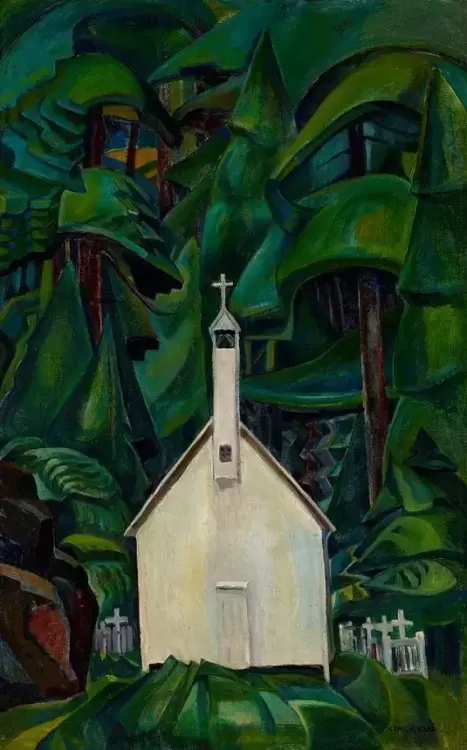An old, windowless church that once stood in the historic village of Yuquot probably would have been forgotten about, living only in the faded memories of the elders, had it not been the subject of a painting made by one of Canada’s most famous artists, Emily Carr, back in 1929.
The original Roman Catholic Church was built by Father Augustin Brabant in 1889 at Yuquot and stood until the 1960’s before it burnt to the ground. By that time it had already been replaced by the more ornate white church that stands there to this day.
The memory of the original church was revived after an Emily Carr painting, owned by the Art Gallery of Ontario, was renamed, in an effort to conform to political correctness.
In 1929 Emily Carr (1871 – 1945) was a struggling artist who specialized in painting scenes of First Nations interest. She favoured modern painting styles like post-impressionism in a world that preferred realism. For this reason, her works did not receive critical acclaim until much later in her life.
With her paintings not producing a viable income, she began writing, dog breeding and ran a boarding house. She would travel to First Nations villages all along the Vancouver Island west coast, Haida Gwaii, and up to Alaska.
Along the way she was given the Nuu-chah-nulth name Klee Wyck, meaning ‘the laughing one’. In 1941 she published her first book, named Klee Wyck, a memoir of Carr’s time spent visiting Nuu-chah-nulth communities. The book was a success and went on to win the prestigious Governor Generals' Award and has been in print ever since.
It was during one of her spring sketching trips in 1929 that Carr became inspired by the little white church nestled in the rugged wilderness of Yuquot. Sometime after she returned to her Victoria home she painted her impression of the church with a backdrop of bold, green forest. She omitted the small houses and outbuildings that surrounded the church and opted for white picket fences and crosses, giving the illusion of a cemetery. This was done, it is said, to emphasize the isolation of the church.
She named her painting ‘Indian Church’, which was the common vernacular of the period.
The name stood for nearly 90 years – longer than the church, which burnt down about 30 years after the painting was created.
In 2018, after consultation with the Mowchaht/Muchalaht First Nation, the Art Gallery of Ontario renamed the painting, ‘Church at Yuquot Village’. They were concerned that the title was inaccurate and that there may be negative connotations associated with the term ‘Indian’.
According to Margarita James of the Land of Maquinna Cultural Society, the Mowachaht, among others, have lived with misnomers for centuries. It started with the name of their people and included the name of their summer village, Yuquot.
Captain James Cook, considered the first European on record to set foot on Vancouver Island, landed at Yuquot in 1778. It was during the first attempts at communication between the Mowachaht and the Englishmen that misinterpretations led to the misnaming of a place and a people for decades to come.
“Consider Nootka. Cook misunderstood visual instructions and the peoples of the area were mislabeled until they decided to revert back to traditional names,” James wrote to Ha-Shilth-Sa.
She is referring to the first interaction between the Mowachaht, who paddled out to greet the approaching sloops Resolution and Discovery, singing and drumming. Gesturing and using their own language, the Mowachaht invited the visitors to come around the point to the sheltered side, “noot’ka ichim!” they yelled.
Cook and his crew misinterpreted what they were saying, believing that they were introducing themselves as Nootka. It was a name that stuck not only to the Mowachaht, but to all Nuu-chah-nulth people for generations.
According to James, Yahtloah’s (Mowachaht Tyee Ha’wilth) people named their summer village Yuquot, meaning exposed to the wind, long before contact with Europeans. Yet their village became known on mainstream maps as Friendly Cove, based on the reception the sailors were given by the Mowachaht.
It has taken 200 years set the record straight, at least in the eyes of mainstream society.
In 1979 the name Nuu-chah-nulth, meaning all along the mountains, was adopted by local First Nations leadership to identify themselves and the inaccurate name Nootka was abandoned.
While Yuquot is still sometimes referred to as Friendly Cove it can be found on maps by its original name, Yuquot.
James says the elders of Mowachaht/Muchalaht met recently and discussed these matters. They talked about how First Nations ended up being called ‘Indians’, beginning with a mistake made by explorer Christopher Columbus who, in 1492, in search of a western route to the south Indies on the Asian continent, instead landed on the eastern shores of North America. Believing that he had landed in Asia, he referred to the inhabitants that greeted him as ‘Indians’.
“North American culture was moving toward ‘political correctness’ with terminology of Aboriginal labels such as ‘Indian’ to Native American and in Canada ‘First Nations’,” James said.
At their elder’s meeting James said that the people just shake their heads when talking about these things. “An elder made a statement about Columbus looking for India, came across us and called us `Indians`. We`re not, he said.”
She went on to say that the discussion was short. The elders said this kind of thing has gone on for so long that they wonder, does it really matter anymore?
James says that the museum in Ontario consulted with Mowachaht/Muchalaht First Nation before changing the name of the painting from Indian Church to Church at Yuquot Village. For that, they are grateful.







